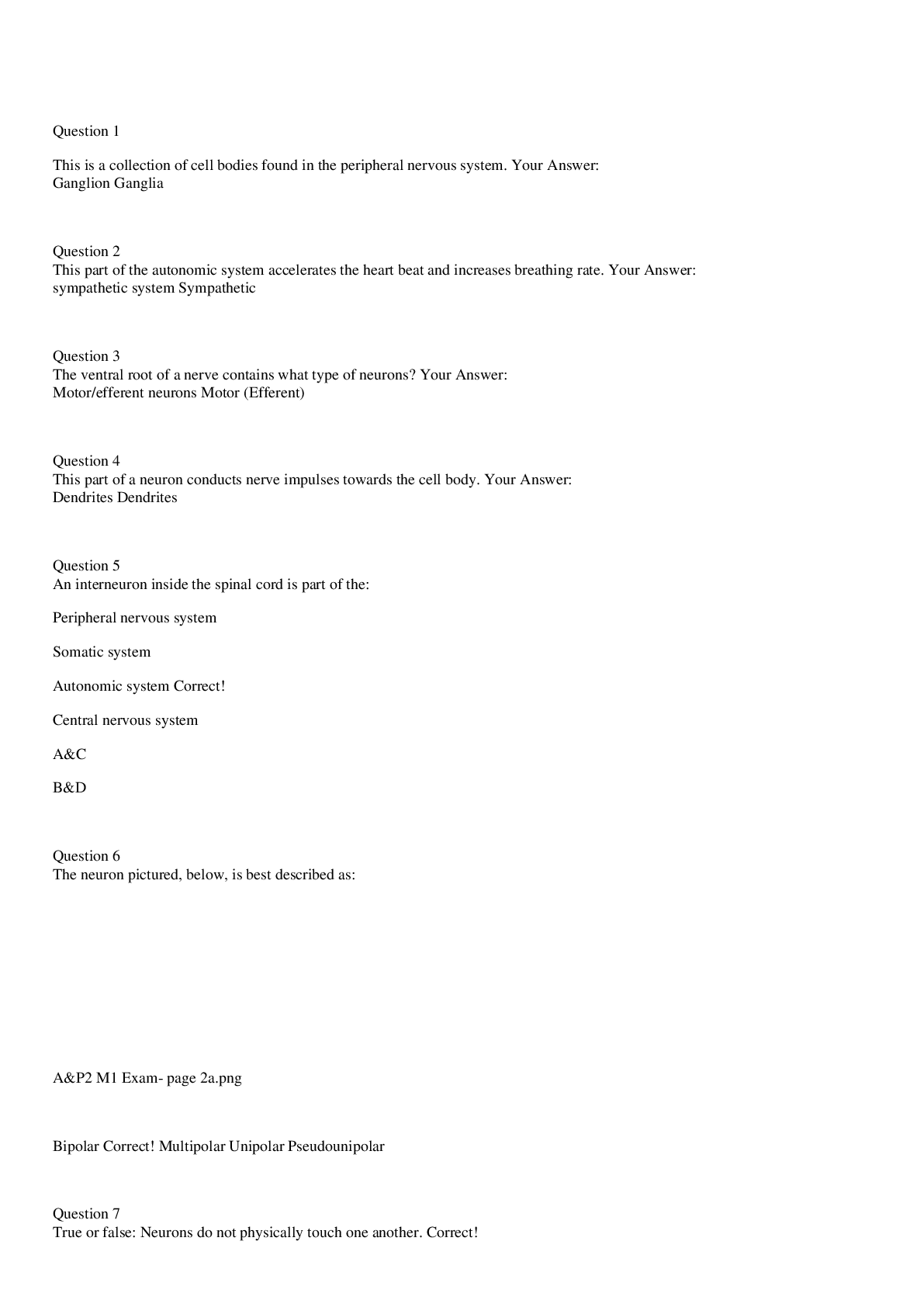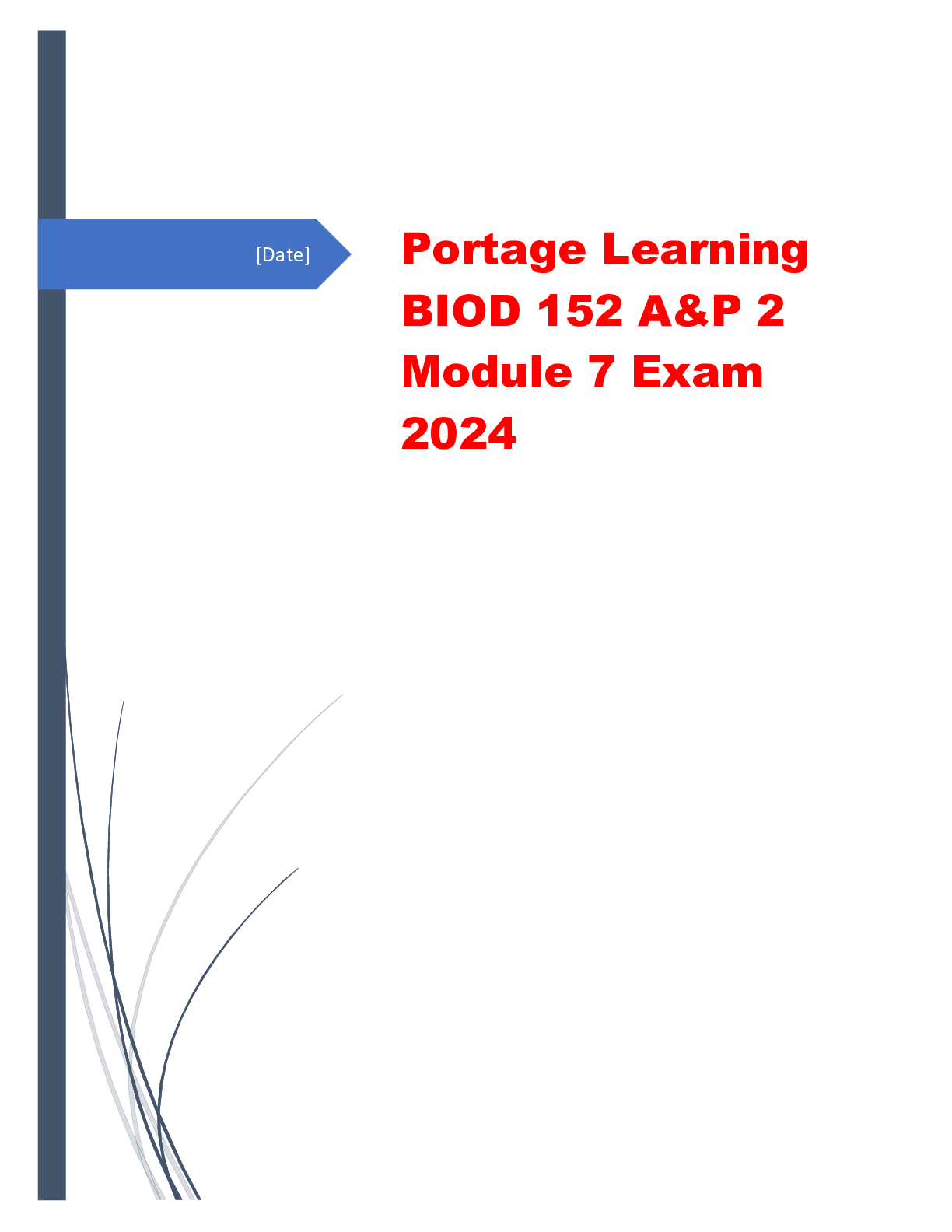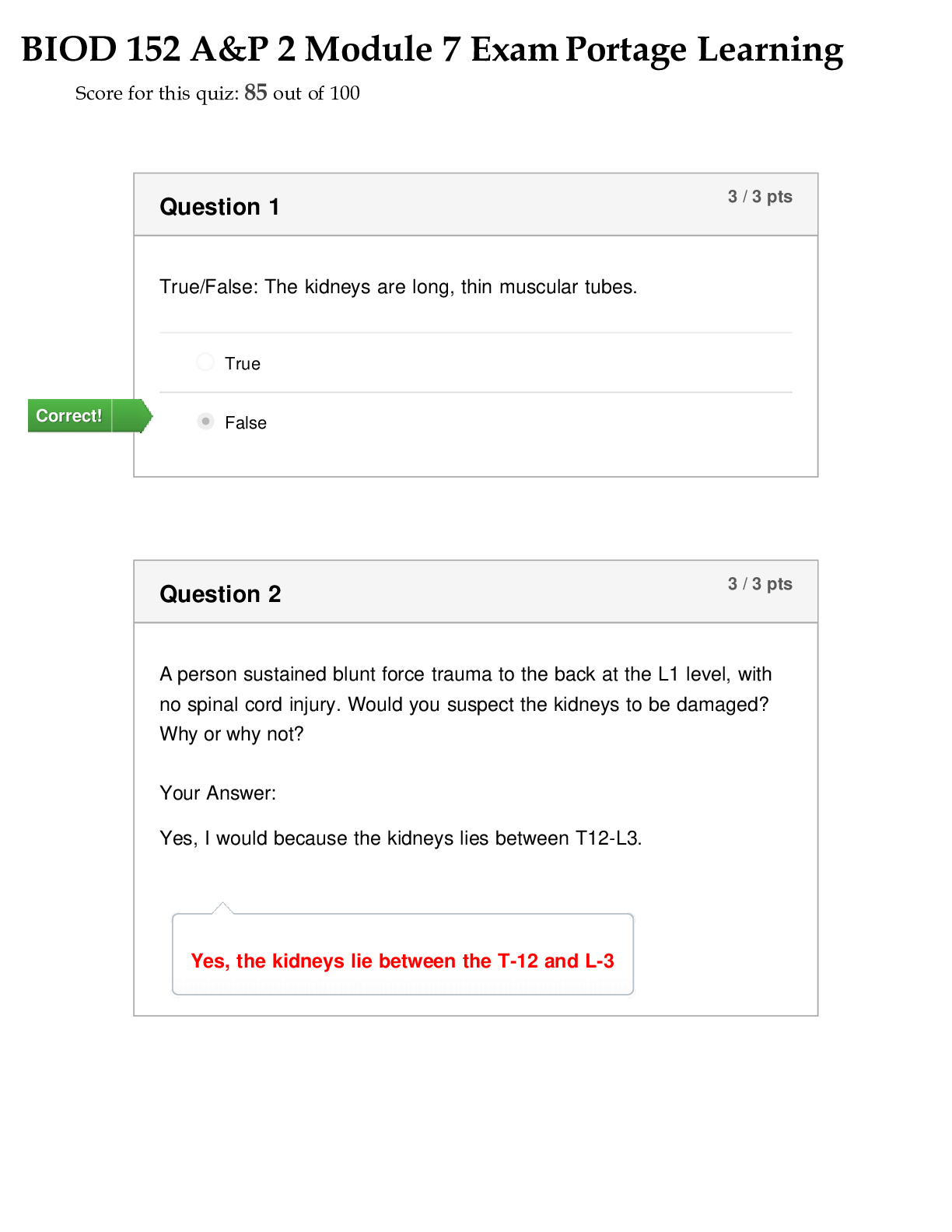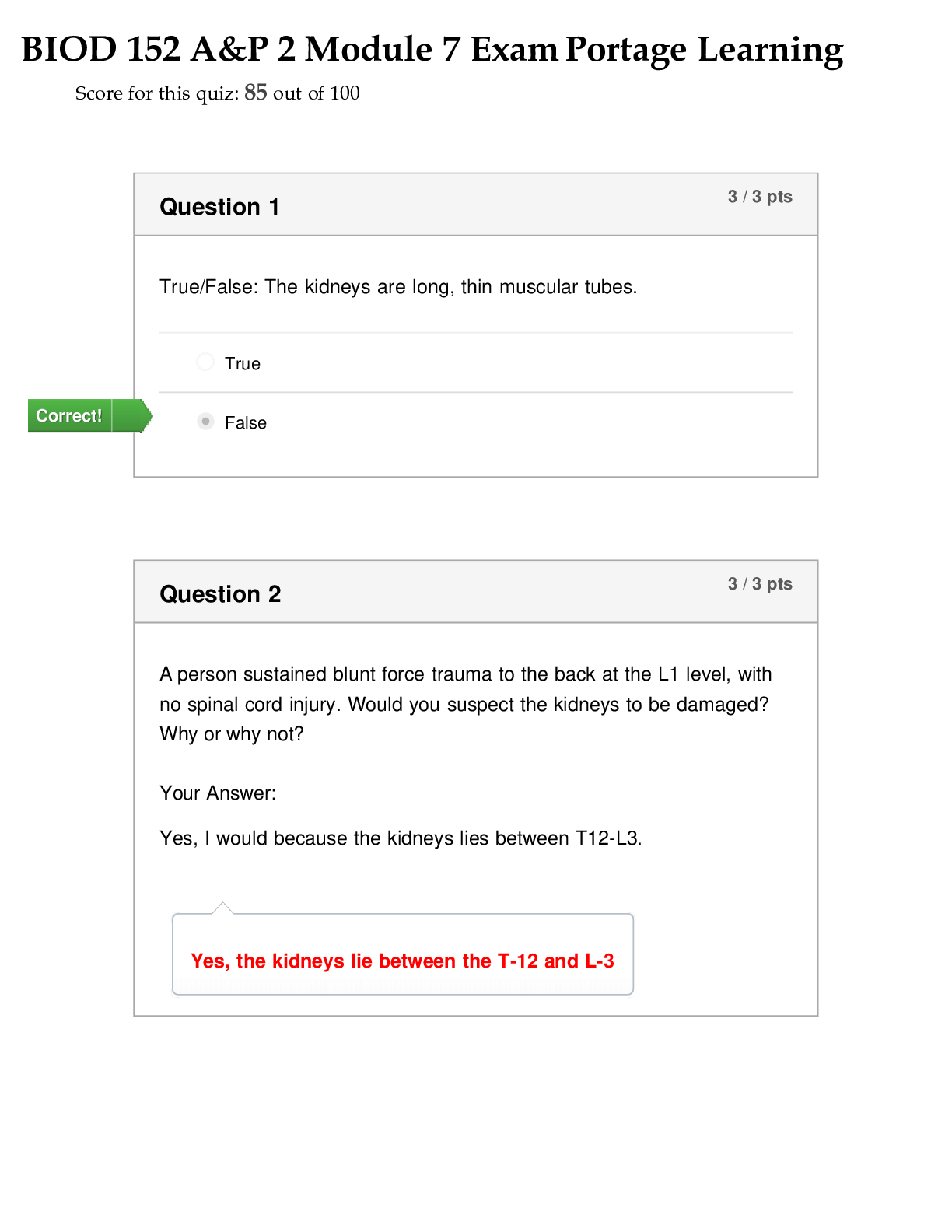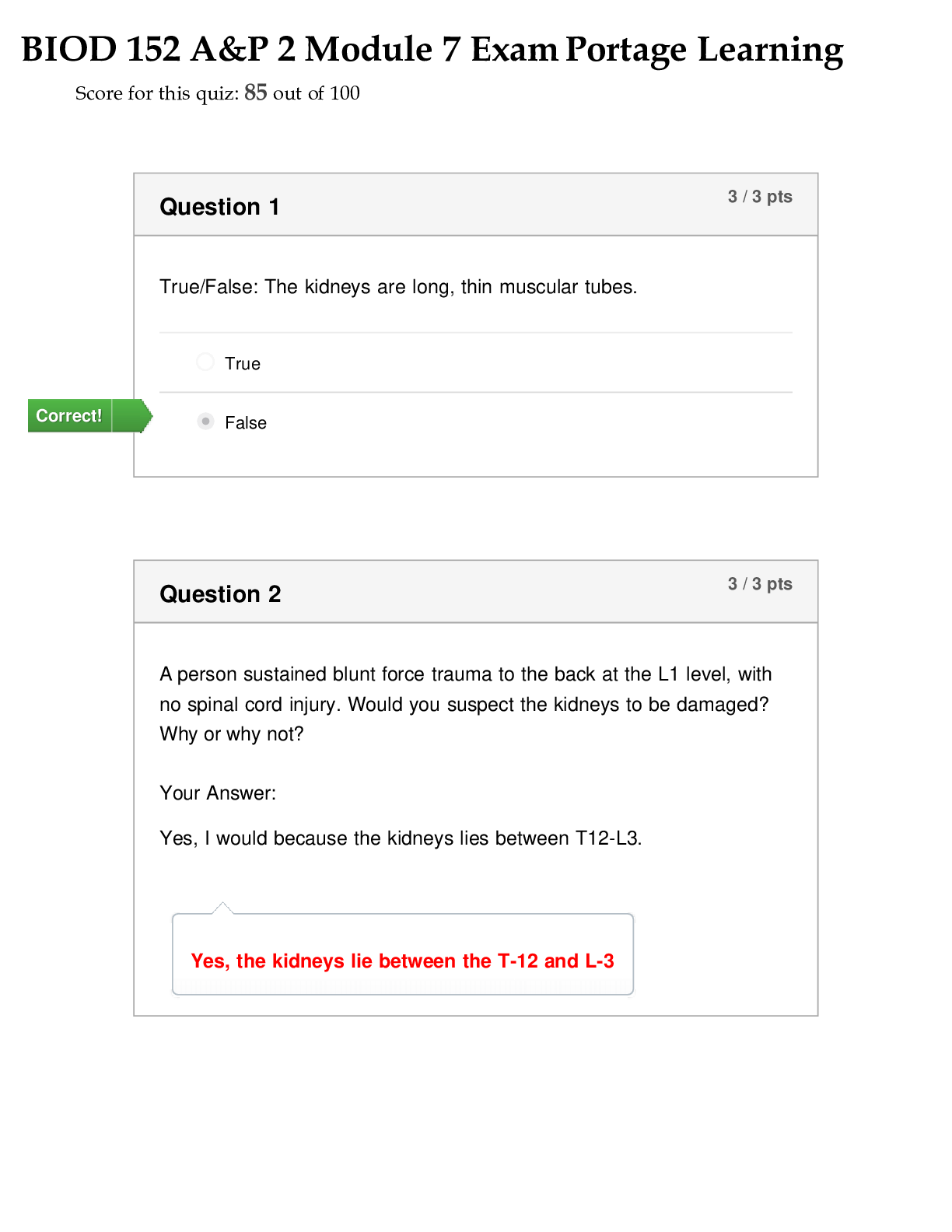Anatomy and Physiology - A&P 2 > EXAM > BIOD 152 A&P 2 Module 3 Exam (TOP SCORE) 100% Guaranteed Pass. (All)
BIOD 152 A&P 2 Module 3 Exam (TOP SCORE) 100% Guaranteed Pass.
Document Content and Description Below
Module 3 of A&P 2 What senses contain specialized receptor cells via specialized somatic and visceral afferents? Smell Touch Equilibrium A&C Question 2 The outer fibrous layer of the eye ... includes the: Sclera and cornea correct Ciliary body and iris Pupil and retina Lens and vitreous fluid Question 3 What portion of the eye supplies blood supply to the other layers of the eye? Choroid (of the middle layer) True or false: Cones operate best in dim light. True False correct What is the correct order of how light passes through the eye? Cornea, Lens, pupil, retina! Cornea, lens, vitreous fluid, retina correct Vitreous fluid fills the space posterior to the lens Lens, retina, cornea, optic nerve Lens, vitreous fluid, optic nerve, retina A patient had a CVA in the area indicated by the red x in the figure, below. What type of blindness is the patient most likely to incur? Explain your reasoning. A. Left eye blindness B. Right eye blindness C. Bilateral left visual field blindness D. Bilateral right visual field blindness. C. Correct answer The right optic tract is damaged. All the sensory information from the left visual fields travels together after the optic chiasm to the right side of the brain. A patient has a brain tumor in the area indicated by the red x in the figure, below. What type of blindness is the patient most likely to incur? Explain your reasoning. A. Left eye blindness B. Right eye blindness C. Bilateral left visual field blindness D. Bilateral right visual field blindness. Your Answer Correct answer A Left eye blindness because there is damage to the left optic nerve. Information from the left visual field has not yet crossed at the optic chiasm. Both peripheral and nasal fields of the left eye would be missing. Question 8 True or False: The lateral fibers of the optic nerves cross at the optic chiasm. True False Question 9 The is controlled by the abducens nerve. Superior rectus Medial rectusorrect! Lateral rectus correct answer Superior oblique Question 10 Your elderly patient is discussing her vision problems. She describes her vision as cloudy and dark. Her vision has progressively worsened over the last year. What most likely is causing the vision problem? Explain your reasoning. A. Cataracts B. Cranial nerve damage C. Brain tumor in the occipital lobe D. Medial rectus damage E. Lateral rectus damage A correct answer Cataracts, due to lens that slowly become hardened over time. Light is not able to be refracted onto the retina. Match the numbers (1-5) in the figure below with the correct terms (A-H). Note: not all terms will be used. 1- A: Scala Tympani 2- B: Facial Nerve 3- C: Tympanic Membrane 4- D: Cochlear duct 5- E: Organ of Corti F: External acoustic meatus G: Cochlear Nerve H: Scala Vestibuli 1 H. Scala Vestibuli Correct! 2 D. Cochlear Duct Correct! 3 E. Organ of Corti Correct! 4 A. Scala Tympani. Correct! 5 G. Cochlear Nerve Other Incorrect Match Options: • B. Facial Nerve • C. Tympanic Membrane • F. External acoustic meatus Which of the following statements is false regarding the external ear? The lobule does not contain cartilage. The auricle funnels sound into the external acoustic meatus. The helix contains cartilage. The external acoustic meatus travels through the parietal bone. Which of the following statements is true regarding the middle ear? It is filled with fluid. It is filled with air. Correct answer The malleus receives vibrations from the stapes The stapes receives vibrations from the cochlea. Which of the following statements is false regarding the inner ear? The organ of Corti is responsible for the body’s auditory sense It is filled with fluid. The cochlea is responsible for the body’s auditory sense. There are two semicircular canals which house sensory receptors. Question 15 Place the terms (A-H) in the correct order for the hearing pathway. Note: not all terms will be used. Funneled vibrations push against the eardrum which moves the 1_Ossicles . The stapes pushes against the Movement of tiny hairs inside the 2 cochlear duct. 3_Organ of Corti causes neurons to send impulses through a cranial nerve to the _Auditory Cortex lobe. 4 , located in the 5 Temporal 1: A. Auditory cortex. 4 2: B. Organ of Corti. 3 3: C. Stereocilia 4: D. Cochlear duct. 2 5: E. Ossicles. 1 F. Facial G. Temporal. 5 H. Parietal Other Incorrect Match Options: • C. Stereocilia • F. Facial • H. Parietal Label the figure below with the correct terminology: (A-E) Your Answer: A Nasal cavity B Olfactory Nerves C Olfactory Bulb D Olfactory Trac E Ethmoid Bone Question 17 True or false: Olfaction is a chemical sense activated by chemical substances dissolved in the nasal mucous membranes. True correct False Question 18 Which of the following is not one of the primary odors in humans? Floral Musky Pungent Putrid correct! Pheromones A person cannot perceive tastes from the anterior portion of the tongue. What nerve is most likely damaged? Your Answer: CN VII Fascial nerve Facial (CN VII) correct Question 20 The tongue helps form food into a compact mass called a . Papillae Gustatory cell Taste Bud Bolus Question 21 The papillae that contain taste buds are . Your Answer: Circumvallate and fungiform Correct Circumvallate Circumvallate and fungiform papillae both contain taste buds Question 22 A patient has lost his sense of smell following a car accident. What term should be documented should to describe his loss of smell? Your Answer: Anosmia True or False: The tongue only contains receptors that are chemoreceptors for taste. True False Describe the steps in the olfactory pathway. Begin in the nasal cavity and end in the specific lobe of the brain. Correct Answer: • Chemicals dissolve in nasal mucosa • Detected by olfactory receptors (bipolar cells) • Olfactory nerves, olfactory bulb, olfactory tract • Temporal lobe of the brain A patient sustains an injury to the malleus. What type of deafness does this patient most likely have? Explain your answer. Your Answer: Conduction deafness • Occurs from damage to the outer or middle ear structures. The malleus is part of the middle ear structures. [Show More]
Last updated: 2 years ago
Preview 1 out of 8 pages

Buy this document to get the full access instantly
Instant Download Access after purchase
Buy NowInstant download
We Accept:

Reviews( 0 )
$13.50
Can't find what you want? Try our AI powered Search
Document information
Connected school, study & course
About the document
Uploaded On
Jun 14, 2022
Number of pages
8
Written in
Additional information
This document has been written for:
Uploaded
Jun 14, 2022
Downloads
0
Views
69



 Questions and Answers 100% VERIFIED.png)
 Questions and Answers 100% correct Solutions.png)






.png)




